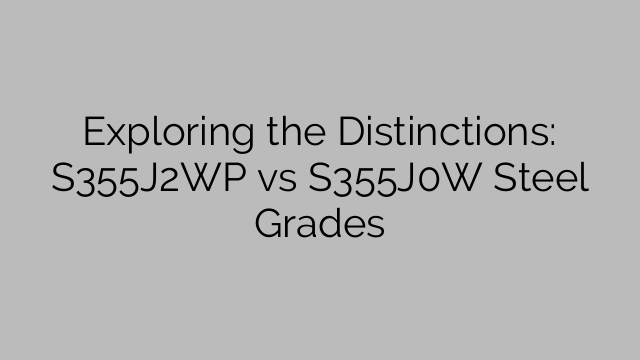Exploring the Distinctions: S355J2WP vs S355J0W Steel Grades
Steel is one of the most versatile and widely used materials in various industries. It is strong, durable, and can be molded into different shapes and sizes, making it suitable for a wide range of applications. Within the steel industry, different grades of steel are designated to cater to specific requirements. Two such grades are S355J2WP and S355J0W, which have distinct characteristics and applications.
S355J2WP and S355J0W are both weathering steel grades, commonly referred to as “corrosion-resistant steel” or “atmospheric corrosion-resistant steel.” These grades are designed to develop a protective oxide layer on the surface, known as a patina, which acts as a barrier against further corrosion. This patina forms when the steel is exposed to the atmosphere, and it protects the underlying material from the detrimental effects of moisture, oxygen, and pollutants.
The primary distinction between S355J2WP and S355J0W lies in their chemical composition. S355J2WP contains additional alloying elements like copper, chromium, and phosphorus, which enhance its corrosion resistance compared to S355J0W. The presence of these elements allows the steel to form a more stable and dense patina, providing better protection against atmospheric corrosion. This makes S355J2WP particularly suitable for outdoor and exposed structures, where it can withstand harsh weather conditions, such as rain, snow, and saltwater.
On the other hand, S355J0W is a basic structural steel without the additional alloying elements found in S355J2WP. As a result, it offers slightly lower corrosion resistance but still possesses sufficient properties to withstand atmospheric corrosion. It is commonly used in applications where the presence of alloying elements is not crucial, such as buildings, bridges, and other structural components. Its cost-effectiveness and ease of fabrication make it a popular choice for various construction projects.
Both S355J2WP and S355J0W are available in various forms, including sheet, plate, tube, and structural sections. These can be further processed and transformed according to specific project requirements. Weldability and machinability are also important factors to consider when using these steel grades. While both grades can be welded and machined, the presence of alloying elements in S355J2WP might slightly affect the process, requiring more specific welding procedures and compatible filler materials.
When it comes to physical properties, S355J2WP and S355J0W possess similar characteristics. They have a minimum yield strength of 355 MPa and a minimum tensile strength of 470-630 MPa. These qualities ensure the structural integrity and durability of the steel, making it suitable for heavy-duty applications.
In conclusion, S355J2WP and S355J0W are two distinct steel grades designed to withstand atmospheric corrosion. While S355J2WP offers superior corrosion resistance due to the presence of alloying elements, S355J0W provides sufficient protection for various construction applications. The decision to use either grade depends on the specific requirements of the project, budget constraints, and environmental conditions. It is important to consult with steel experts or engineers to determine the most suitable grade for your particular application.

